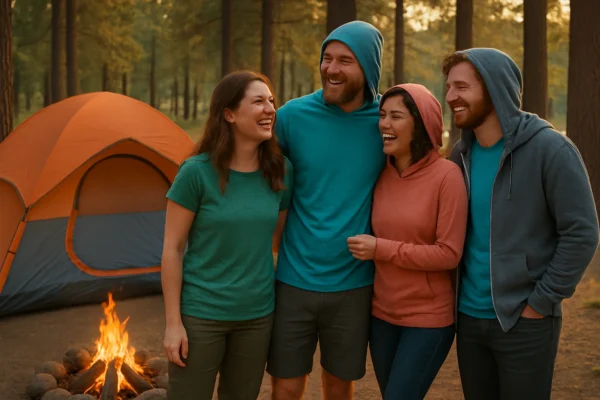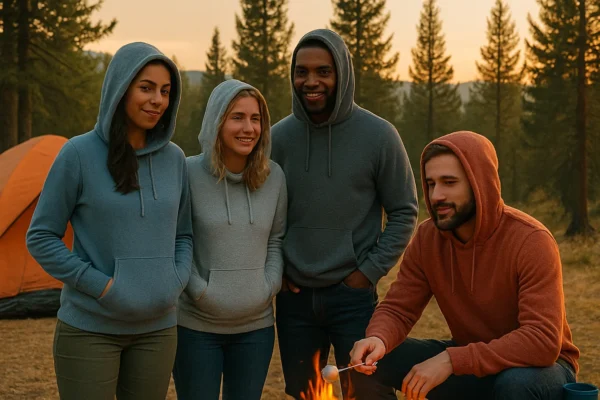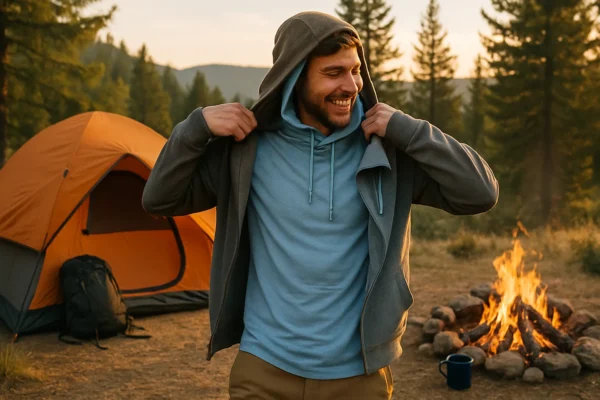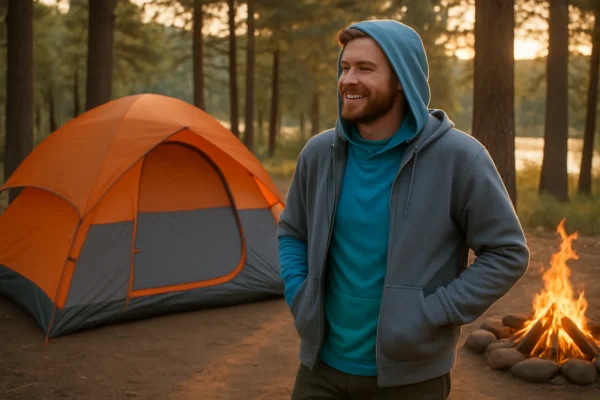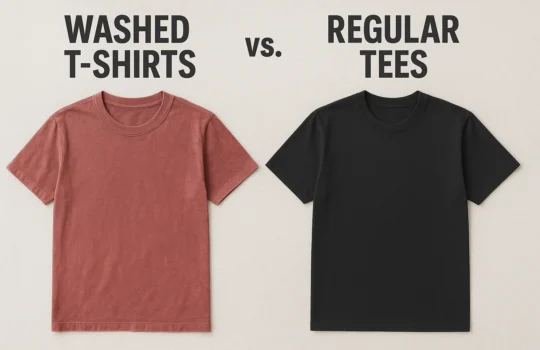Camping Apparel Essentials: How to Layer T‑Shirt, Hoodie & Sweatshirt
When preparing for a camping trip, many people focus on gear like tents, sleeping bags, or cooking supplies, but choosing the right clothing is just as essential. The clothes you wear directly affect your comfort, your ability to regulate body temperature, manage moisture, and protect yourself from the sun.
Whether you’re hiking under the sun, relaxing at camp in the evening chill, or navigating unpredictable weather, each clothing layer plays a critical role. This article focuses on three key layers that should be part of every camper’s wardrobe: the T-shirt as the base layer for breathability and moisture control, the hoodie for sun protection or casual wear, and the sweatshirt as a reliable mid-layer to keep you warm when temperatures drop.
Camping T-Shirts: The Essential Base Layer
When it comes to camping, the T-shirt you wear might not seem like a big deal until you’re hours into a sweaty hike, the sun’s beating down, and your shirt feels like a wet towel. A quality camping T-shirt does more than just cover your back; it acts as the foundation of your clothing system, playing a key role in comfort, mobility, and temperature control throughout your trip. Let’s break down what makes a T-shirt ideal for camping and why your base layer deserves serious consideration.
Material & Performance
The material of your camping T-shirt affects how well it manages moisture and regulates your body temperature. Synthetic fabrics like polyester and nylon are popular choices for active campers and hikers because they’re lightweight, moisture-wicking, and quick-drying. These fabrics pull sweat away from your skin and dry rapidly, helping you stay cool and dry during high-output activities.
For those on multi-day trips or looking for more natural options, merino wool is a standout. Unlike traditional wool, merino is soft, breathable, and thermoregulating, it keeps you warm when it’s cold and cool when it’s hot. Even more impressively, merino wool naturally resists odors, making it ideal for wearing several days in a row without needing a wash.
Sun & Odor Protection
Spending long hours outdoors means you’re exposed to the sun much more than usual. That’s where UPF-rated T-shirts come in. A good camping T-shirt should have a UPF rating of 30–50+, offering consistent protection from harmful UV rays. This is especially important in higher altitudes or during extended time in direct sunlight.
In addition to sun protection, odor control is key, especially on trips where laundry isn’t an option. Some synthetic shirts come treated with anti-odor or antimicrobial technologies, while merino wool naturally resists bacteria and odor buildup. Both options help keep you feeling fresher for longer.
Fit & Practical Features
Fit and functionality matter just as much as fabric. Look for shirts that are breathable and slightly stretchy to accommodate movement on the trail. Features like raglan sleeves, ventilation panels, or mesh inserts can improve mobility and airflow, especially in warm weather.
Finally, consider packability and drying time. A good camping T-shirt should dry quickly, allowing you to wash it in the evening and wear it again the next morning. Lightweight designs that pack down small are also useful when space is limited in your backpack.
Camping Hoodie: Versatile Sun & Casual Layer
A hoodie might not be the first item you pack for a camping trip, but it should be. Today’s camping hoodies are a far cry from the bulky sweatshirts you wear at home: they’re lightweight, breathable, and built to handle both intense sun and early morning chill. Whether you’re moving under the midday sun or unwinding as the air cools, a quality camping hoodie keeps you covered without sacrificing comfort. Here’s what makes a good camping hoodie worth the space in your pack.
Functional Uses
One of the biggest advantages of a camping hoodie—especially lightweight sun hoodies—is their ability to protect you from the elements without overheating. While hiking, canoeing, or fishing, your neck, shoulders, and arms are directly exposed to UV rays. A good sun hoodie acts like wearable shade, often featuring UPF protection and moisture-wicking fabric to keep you dry and protected even during long, sweaty days.
Beyond activity use, these hoodies shine during downtime too. Their breathable, lightweight design makes them a perfect casual layer to throw on around camp, especially during cool mornings or evenings when temperatures dip just enough to need an extra layer. The hood itself adds extra warmth and coverage without the need for a hat.
Material Characteristics
The best camping hoodies are made with synthetic blends, typically polyester with a bit of elastane or spandex. This combination offers stretch for mobility, comfort next to skin, and built-in UV protection—often rated UPF 30 or higher. Many are also treated for odor resistance, allowing for extended wear without worry.
What makes these hoodies stand out is their ability to breathe well, even under intense heat. Unlike heavier mid-layers, a modern sun hoodie is designed to vent heat while still offering protection from both sun and bugs. These materials also dry quickly, which is essential if you’re sweating or get caught in light rain.
Camping Sweatshirt: Insulating Mid Layer & Cozy Campwear
When the sun dips below the trees and the temperature starts to drop, there’s nothing quite like pulling on a warm sweatshirt at camp. While base layers and sun hoodies handle daytime activity, the camping sweatshirt steps in as your go-to mid-layer, delivering reliable warmth, comfort, and a bit of that “home away from home” coziness. Whether you’re sitting around a campfire, brewing coffee at dawn, or just hanging out after a long hike, a well-chosen sweatshirt can make the difference between chilly discomfort and all-out relaxation.
Purpose & Timing
The camping sweatshirt shines in those cooler transitions—early mornings, shady forest trails, and post-dusk campfire sessions. As a mid-layer, it traps body heat efficiently without being overly bulky, making it easy to layer under a shell jacket or over a T-shirt. It’s ideal for when you’re not moving intensely, like cooking breakfast at camp, setting up a tent, or simply winding down under the stars.
It also pulls double duty as camp loungewear, offering softness and warmth after a long day outdoors. Compared to more technical layers, sweatshirts feel familiar and comforting, just right for low-key moments when performance isn’t the priority.
Material & Warmth
Most high-quality camping sweatshirts are made from fleece, either midweight or heavyweight, depending on the expected temperature. Fleece is excellent at providing quick warmth, even if it gets a little damp. It’s also breathable, meaning it won’t trap too much heat if you’re lightly active around camp.
If your trip leans more casual or the weather is dry and mild, a cotton-blend fleece sweatshirt can be a cozy choice. While cotton isn’t ideal for sweaty activities or wet conditions since it retains moisture and loses insulation when damp—it’s soft, quiet, and perfectly fine for laid-back use around camp when staying dry isn’t an issue.
Fit & Functionality
When choosing a camping sweatshirt, go for a relaxed or slightly roomy fit. This allows for comfortable layering and creates small air pockets (also called “loft”) that help trap heat. The right fit also makes it easier to pull the sweatshirt on or off as temperatures change throughout the day.
Added features like a hood offer bonus warmth and wind protection for your head and neck. Kangaroo pockets are great for warming hands or stashing snacks and headlamps, while a zip-up front gives you better ventilation control. These small details can make a big difference in how often you reach for your sweatshirt on a trip.
Layer Smart: How Three Simple Pieces Can Handle Any Camping Weather
A good camping outfit isn’t about packing dozens of clothing items, it’s about selecting the right few that can work together efficiently. Layering is the key to staying comfortable in the outdoors, where temperatures and activity levels can shift dramatically throughout the day. The T-shirt, sun hoodie, and sweatshirt form a simple, effective system that covers everything from midday hikes to chilly evenings around the campfire. Here’s how these three pieces complement each other and keep your pack light without sacrificing comfort.
Layering Strategy
Each of the three layers serves a specific role, and when combined thoughtfully, they handle a wide range of camping conditions:
- T-Shirt (Base Layer): This is your next-to-skin layer and should be moisture-wicking and breathable. Whether it’s a synthetic blend or merino wool, the T-shirt helps keep sweat off your skin and provides light sun protection during mild conditions.
- Sun Hoodie (Mid Cover Layer): When the sun gets intense or you’re moving through exposed terrain, the sun hoodie goes over the T-shirt to shield your arms, neck, and head from UV rays. Because it’s lightweight and breathable, you can keep it on even while active.
- Sweatshirt (Outer or Insulation Layer): As the day winds down and temperatures start to drop, the sweatshirt comes out. Whether it’s a fleece hoodie or cotton-blend pullover, this layer traps body heat and keeps you cozy without being too bulky.
Example day: Start your morning with a merino or polyester T-shirt. As the sun rises and you hit the trail, pull on a sun hoodie for UV protection and breathability. Once the sun sets or the breeze picks up at camp, throw on a sweatshirt to retain warmth through the evening.
Versatility & Packing Tips
The beauty of this layering system is its adaptability. Each piece overlaps in function, allowing you to adjust based on your environment and activity level.
- A sun hoodie doesn’t just serve you on the trail, it doubles as a lightweight camp layer, perfect when it’s too warm for a sweatshirt but too cool for just a T-shirt.
- Choosing a merino wool T-shirt means you can wear it multiple days in a row without odor, reducing the need for extras. Meanwhile, a fleece sweatshirt provides warmth that still works if damp, a huge plus in unpredictable weather.
When packing, focus on multi-use, breathable, and quick-drying materials. With just these three layers, you can comfortably handle cool mornings, hot midday sun, and chilly nights—all without overstuffing your bag. For most spring through fall trips, this simple system is more than enough.
3 Common Mistakes & How to Avoid Them
Even experienced campers sometimes get clothing choices wrong. A poorly chosen layer or mistimed wardrobe change can leave you cold, sweaty, sunburned, or just plain uncomfortable. Understanding a few common pitfalls and how to avoid them—can make the difference between an enjoyable trip and a miserable one. Below are some of the most frequent clothing mistakes made during camping trips, especially when it comes to layering, and how you can stay ahead of them.
Relying on Cotton
One of the most common mistakes? Wearing cotton as a base or mid layer. While cotton sweatshirts or tees might feel soft and cozy, they retain moisture—whether from sweat, rain, or humidity. Once wet, cotton dries slowly and draws heat away from your body, which can lead to chills, even in mild weather.
This becomes especially risky in colder or high-altitude environments, where a damp cotton shirt can sap your body warmth dangerously fast. If you’re hiking or doing anything active, save cotton for camp-only wear, and rely instead on moisture-wicking synthetics or merino wool for base and mid-layers.
Ignoring UPF or Breathability
It’s easy to assume any long-sleeve shirt or hoodie protects you from the sun, but not all fabrics offer reliable UV protection. Wearing layers without a proper UPF rating (Ultraviolet Protection Factor)—typically 30 or higher—can still allow sunburn through the fabric, especially after sweat or stretching.
Also, breathability matters just as much. Wearing tightly woven, non-breathable fabrics on hot days can trap heat and sweat, leading to overheating and discomfort. Instead, look for technical fabrics designed with mesh panels, ventilated weaves, or moisture-wicking technology. Pay attention to lighter shades, which can reflect heat, but be sure they’re paired with UV-rated fabrics to avoid exposure.
Not Adjusting Layers Early Enough
A mistake many people make—especially on cooler mornings—is waiting too long to shed layers. It might feel good to stay bundled up as you start moving, but once you begin hiking or doing chores, your body heats up fast. If you delay in adjusting your layers, you risk over-sweating, which can soak your insulation layers (like a fleece sweatshirt), making them less effective later.
The key is to be proactive, not reactive. As soon as you feel yourself warming up, unzip or remove a layer. Conversely, once you stop moving and start to cool down, add a layer before you feel cold.
Simple but Smart: The Clothing Combo Every Camper Needs
When packing for your next camping trip, don’t overcomplicate your clothing system. With just three well-chosen layers—a moisture-wicking T-shirt, a lightweight hoodie, and a cozy sweatshirt—you can handle most outdoor conditions with confidence and comfort. Start with a synthetic or merino wool T-shirt that keeps sweat at bay and ideally offers UPF protection. Layer on a sun hoodie during the day for breathable coverage against UV rays, especially on the trail or water. As the temperature drops, reach for a fleece sweatshirt that adds warmth without bulk, perfect for campfire evenings or chilly mornings.
These three items strike a smart balance between function, comfort, and packability. Whether you’re hiking under the sun, relaxing in the shade, or bundled up under the stars, this system covers the essentials without weighing you down.

